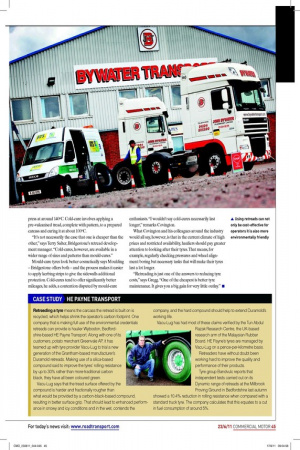CASE STUDY HE PAYNE TRANSPORT
Page 39

If you've noticed an error in this article please click here to report it so we can fix it.
Retreading a tyre means the carcass the retread is built on is recycled, which helps shrink the operator’s carbon footprint. One company that is making full use of the environmental credentials retreads can provide is haulier Wyboston, Bedfordshire-based HE Payne Transport. Along with one of its customers, potato merchant Greenvale AP, it has teamed up with tyre provider Vacu-Lug to trial a new generation of the Grantham-based manufacturer’s Duramold retreads. Making use of a silica-based compound said to improve the tyres’ rolling resistance by up to 30% rather than more-traditional carbon black, they have all been coloured green.
Vacu-Lug says that the tread surface offered by the compound is harder and fractionally rougher than what would be provided by a carbon-black-based compound, resulting in better surface grip. That should lead to enhanced performance in snowy and icy conditions and in the wet, contends the company, and the hard compound should help to extend Duramold’s working life.
Vacu-Lug has had most of these claims verified by the Tun Abdul Razak Research Centre, the UK-based research arm of the Malaysian Rubber Board. HE Payne’s tyres are managed by Vacu-Lug on a pence-per-kilometre basis.
Retreaders have without doubt been working hard to improve the quality and performance of their products.
Tyre group Bandvulc reports that independent tests carried out on its Dynamic range of retreads at the Millbrook Proving Ground in Bedfordshire last autumn showed a 10.4% reduction in rolling resistance when compared with a standard truck tyre. The company calculates that this equates to a cut in fuel consumption of around 5%.













































